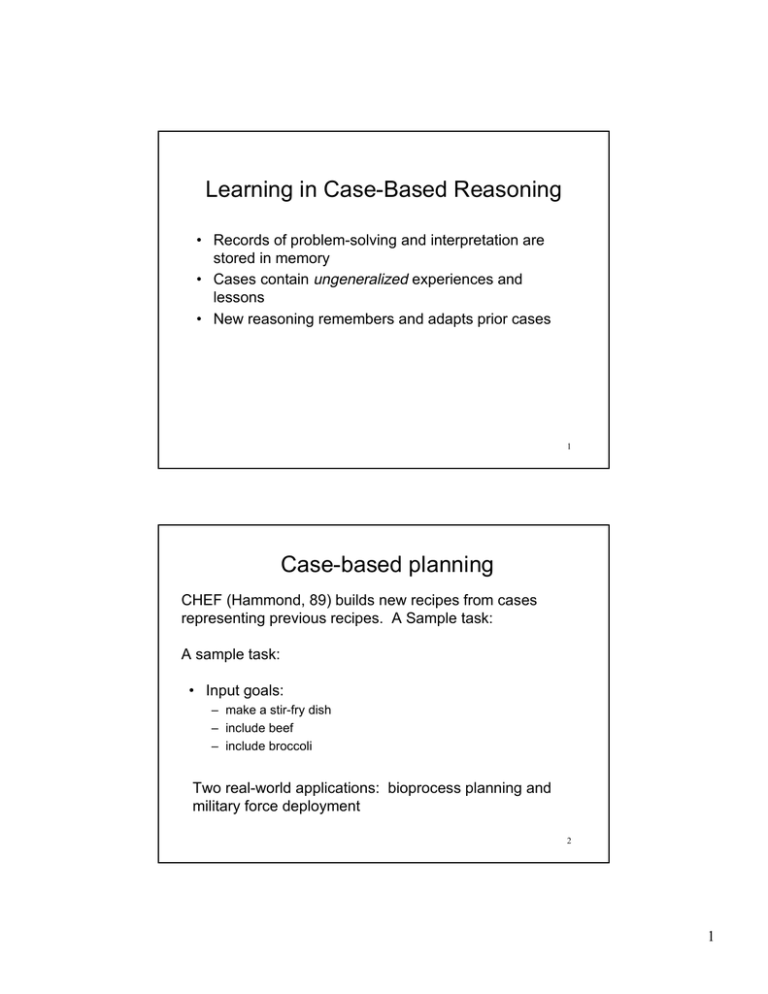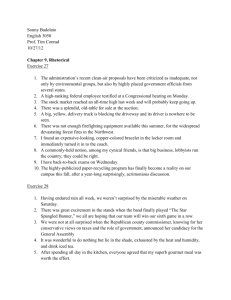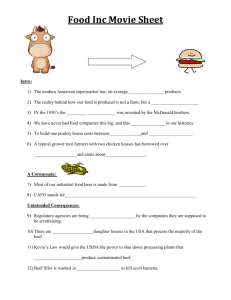Learning in Case-Based Reasoning
advertisement

Learning in Case-Based Reasoning • Records of problem-solving and interpretation are stored in memory • Cases contain ungeneralized experiences and lessons • New reasoning remembers and adapts prior cases 1 Case-based planning CHEF (Hammond, 89) builds new recipes from cases representing previous recipes. A Sample task: A sample task: • Input goals: – make a stir-fry dish – include beef – include broccoli Two real-world applications: bioprocess planning and military force deployment 2 1 Similarity and retrieval • CHEF bases similarity judgments on a hierarchy of important features • Dish type is most important, then meat type, then vegetable types, … • Example: Given the goal of beef and broccoli, CHEF retrieves recipe for beef and green beans. 3 Adapting a case to fit CHEF uses two types of adaptation knowledge: • modification rules for structural changes (e.g., additions and reorderings) • ingredient critics to adjust for individual items 4 2 A modification rule for adding fruit to a souffle (add:mod index (fruit style-souffle) amount (cup number (1)) steps ((do (chop object ?new-item size (pulp))) (before (pour object ?object into (nine-inch-baking-dish)) do (mix object ?new-item with ?object)))) 5 An ingredient critic for shrimp (add:crit shrimp binds (shrimp *new-item*) steps ((before (cook-step object *new-item*) do (shell object *new-item*)))) 6 3 Summary of CHEF’s Architecture 7 How CHEF Generates a Plan for Beef and Broccoli • Retrieve beef and green beans • Apply modification rule to substitute broccoli for green beens • Apply ingredient critic to add chopping step and adjust cooking time 8 4 Voilà! Beef with broccoli • • • • • • • • • Ingredients: 1/2 pound beef, 1 tsp sugar, 2 Tbs soy sauce, 1/2 lb. Broccoli, 1 tsp rice wine,1 tsp salt, 1/2 tsp corn starch,1 clove garlic Chop the garlic into pieces the size of matchheads. Shred the beef. Marinate the beef in the garlic, sugar, corn starch, rice wine and soy sauce. Chop the broccoli into chunks. Stir fry the spices, rice wine and beef for one minute. Add the broccoli to the spices, rice wine and beef. Stir fry the spices, rice wine, broccoli and beef for three minutes. Add the salt. 9 Evaluating result • Check result against adapted recipe goals: – – – – – – The beef is tender. The dish tastes savory. The broccoli is crisp. The dish is salty. The dish is sweet. The dish tastes like garlic. • Plan is executed (in simulator) and checked against expectations. But the broccoli is soggy! 10 5 CHEF's recovery from failure • • Explain: Beef releases water => broccoli steams. Identify problem pattern: – Water released by cooking the beef disabled ``dry wok.'' – SIDE-EFFECT:DISABLED-CONDITION:CONCURRENT • Retrieve repair strategies for the problem pattern: – Split-and-reform. – Alter-plan:side-effect – Adjunct-plan • • Split-and-reform applies. New plan works! 11 Failure Recovery Architecture 12 6 Learning from experience • CHEF stores plans under the combinations of goals they satisfy, including the problems they avoid. • It learns: – A new case: the recipe for beef and broccoli, indexed under • Goals (stir-fry, beef, broccoli) • Problem avoided (avoids bad meat/vegetable interaction) – A rule for anticipating meat/crisp vegetable interaction problems 13 CBR as Learning • Learning from success – Save successful solutions • Learning from failures – Learn to anticipate and avoid problems • Purposes of learning – Improving competence – Speedup 14 7 Prodigy Evaluation (Veloso, 94) 15 The Hard Problems • • • • Indexing Situation assessment Capturing adaptation knowledge Keeping cases and indices up-to-date 16 8 Most Active Research Areas in CBR • Case adaptation • Case-base maintenance • Interactive CBR 17 Better Living Through Machine Learning VTT Biotechnology in Helsinki has applied CBR to beer production and fielded their system in Finnish breweries. 18 9




